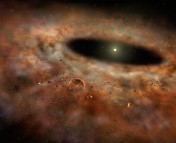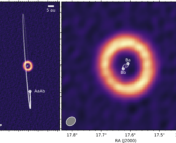Title: Snapshot of a magnetohydrodynamic disk wind traced by water maser observations
Authors: Luca Moscadelli, Alberto Sanna, Henrik Beuther, André Oliva, Rolf Kuiper
First Author’s Institution: NAF-Osservatorio Astrofisico di Arcetri, Firenze, Italy
Status: Published in Nature Astronomy [closed access]
Have you ever seen someone fighting with their long hair? Or maybe you experienced the struggle yourself? It doesn’t matter how careful you are, it always ends up tangled (except maybe in Disney movies…). We are not alone: protoplanetary disks, the sites of planet formation, struggle with the same issue!
Do protoplanetary disks have hair?
Technically, they don’t. But there is something behaving similarly in some aspects: magnetic field lines. Magnetic fields are common in our Universe, so it is not surprising that some protoplanetary disks inherit them as well.
Magnetic fields greatly impact the disk’s evolution. One important mechanism triggered by magnetic fields are magnetic disk winds. Those winds are gas outflows away from the disk and are a very efficient mechanism to transport angular momentum in a protoplanetary disk. Angular momentum transport is a key ingredient for accretion, which is the flow of gas and other material in the disk toward and onto the star. The accretion rate in a protoplanetary disk determines many evolutionary aspects and plays a major role in planet formation.
Magnetic disk winds can occur when the magnetic field lines are structured in a V-shape as shown in Figure 1. In this configuration, the field lines are anchored to the disk and rotate like a solid rod in a region where the magnetic pressure is higher than the ram pressure. Ram pressure is the pressure a moving body experiences within a gas or fluid and can be compared to the headwind we feel on Earth, while magnetic pressure occurs due to the magnetic field.
Charged particles can move along magnetic field lines. By flowing away from the disk along the lines, those particles create the phenomenon we specifically refer to as magnetic disk winds.
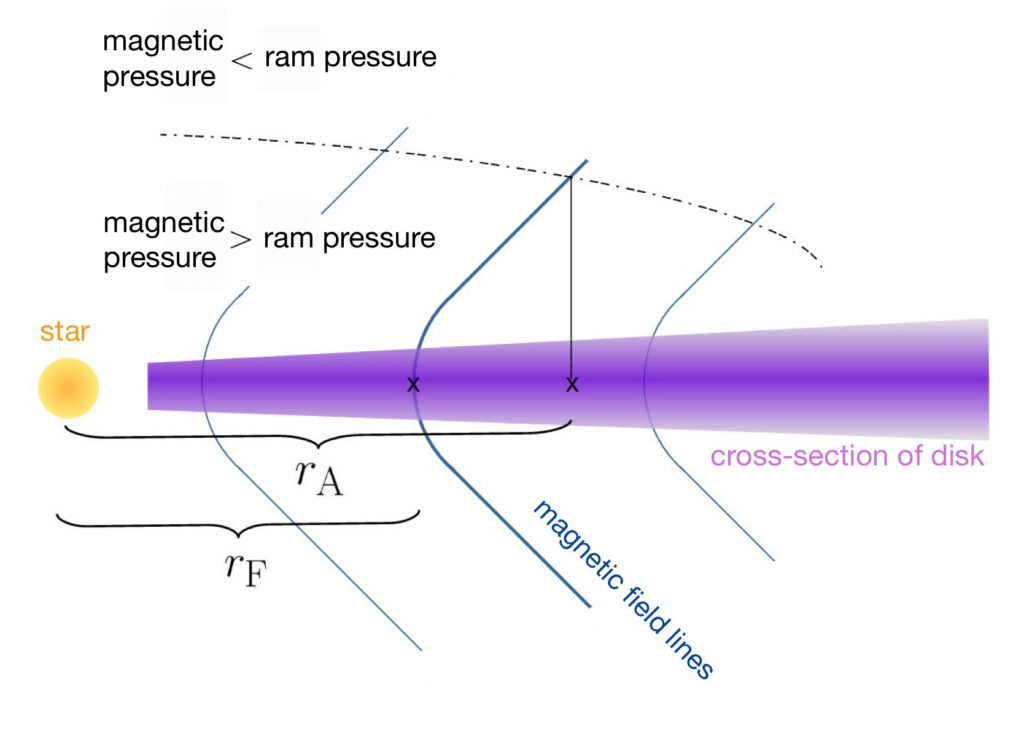
Help – my hair is all tangled!
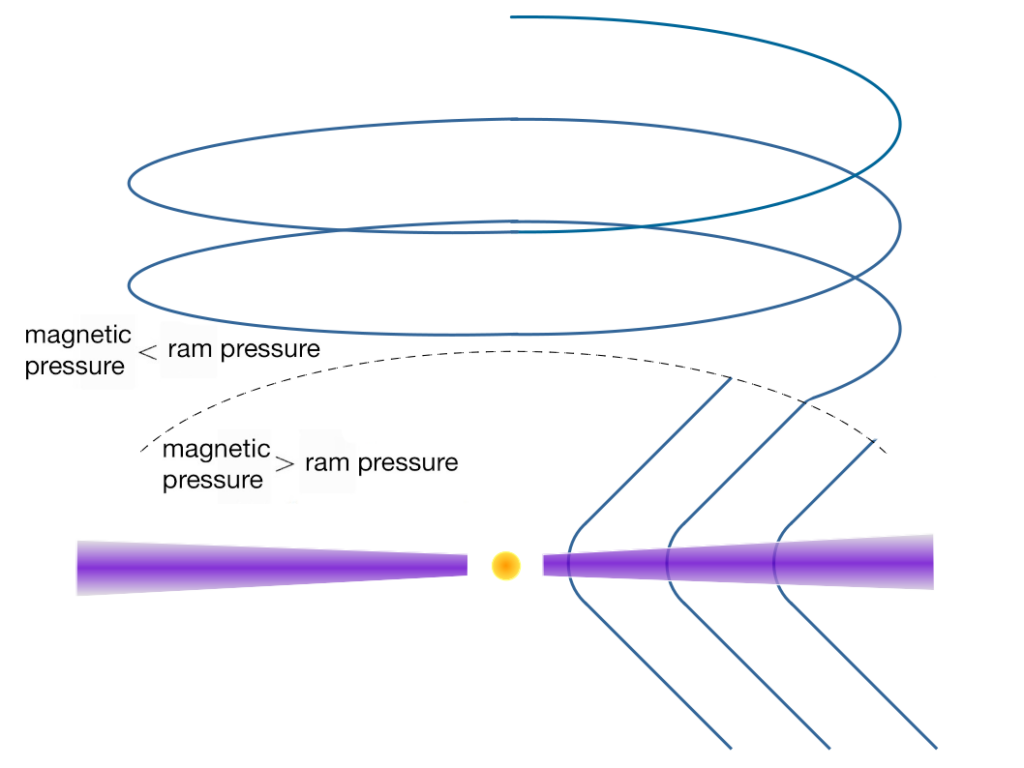
The magnetic field lines stick out of protoplanetary disks like hair, and as long as the magnetic pressure is strong enough, everything is nice and ordered just like combed hair. This is the region close to the disk in Figure 1. But outside this region, further away from the disk (above the dashed line in Figure 1), the magnetic pressure becomes lower than the ram pressure and things start to get chaotic. The magnetic field lines no longer rotate as solid rods but start to bend. Because the disk unceasingly rotates, the field lines start to wind up as indicated in Figure 2. This is how the disk’s hair gets all tangled!
Observing tangled protoplanetary hair
One big challenge is that magnetic disk winds are very hard to observe. The winds have an extremely low density and protoplanetary disks are so far away that at first glance, it seems impossible to detect. Until now, there were only few (and mostly indirect) indications that magnetic disk winds exist.
The authors of today’s paper, however, made exciting observations: they traced the magnetic field lines by observing maser events, which can be caused by particles in the magnetic wind. A maser event works very similarly to a laser, only that instead of light in the optical regime, radiation in microwave frequencies is emitted. It is well known that masers can naturally occur, but the details of how they work are still ongoing research. The authors of today’s paper use maser emission as tracers for the magnetic field lines of a protoplanetary disk (Figure 3).
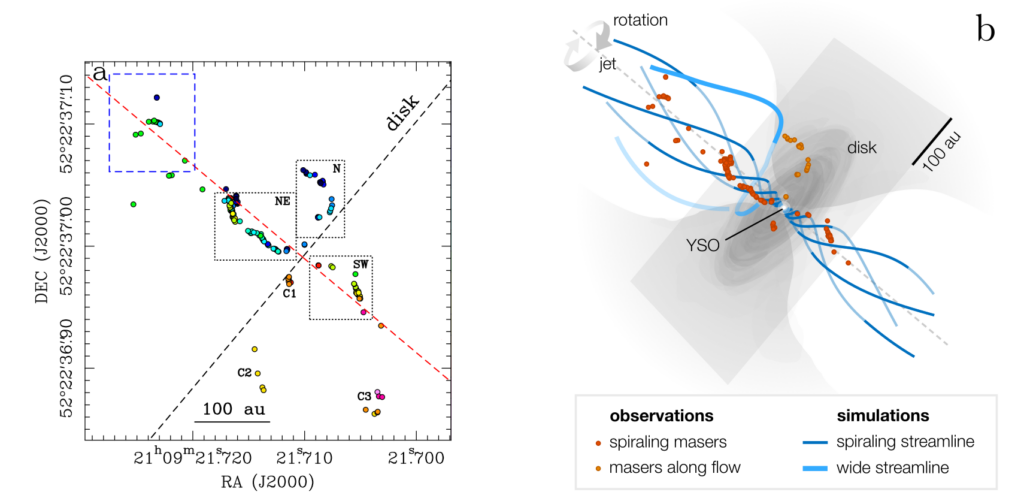
In today’s paper, the authors find maser emissions organized in a spiral structure (Figure 3, left panel, boxes labeled with “NE” and “SW”), proving that protoplanetary hair gets tangled high above the disk plane. Additionally, they find maser observations (Figure 3, left panel, box labeled with “N”) that trace the region close to the disk with high magnetic pressure, where the field lines rotate as solid rods. To compare their observations to theoretical models, the authors perform magnetohydrodynamic simulations (magnetohydrodynamics refers to fluids moving in magnetic fields) and find a configuration similar to their observations (Figure 3, right panel). Their simulations agree with the magnetic wind theory that the two different pressure regions exist. The fact that their observations agree with the theory and the simulations as well, strongly indicates that magnetic winds are a realistic scenario in protoplanetary disks.
(Hot tip: the authors present their observations in this video, also showing and comparing previous observations of the same object.)
The observations in today’s paper are novel in many ways. Magnetic disk winds have never been observed in such detail before. There are some previously existing observations that indicate a spiral structure similar to the structure the authors found in their work. However, the lower region has never been observed before. The observations in today’s paper are a great step to put observational constraints on theoretical models for magnetic disk winds. Another novel aspect about the observations is the spatial resolution: it is as good as 0.05 AU, which is approximately 7 million kilometers or 4 million miles. This means that the authors can distinguish maser locations that are as close together as 0.05 AU. This is one of the highest resolved observations there are!
Today’s paper proves that tangled hair is a universal problem. Who would have thought that poor protoplanetary disks also struggle with hair issues? However, there is one difference: I don’t think there is a comb large enough to untangle protoplanetary hair…
Astrobite edited by Lindsay DeMarchi
Featured image credit: Figure 2 in today’s paper, edited by Lina Kimmig

